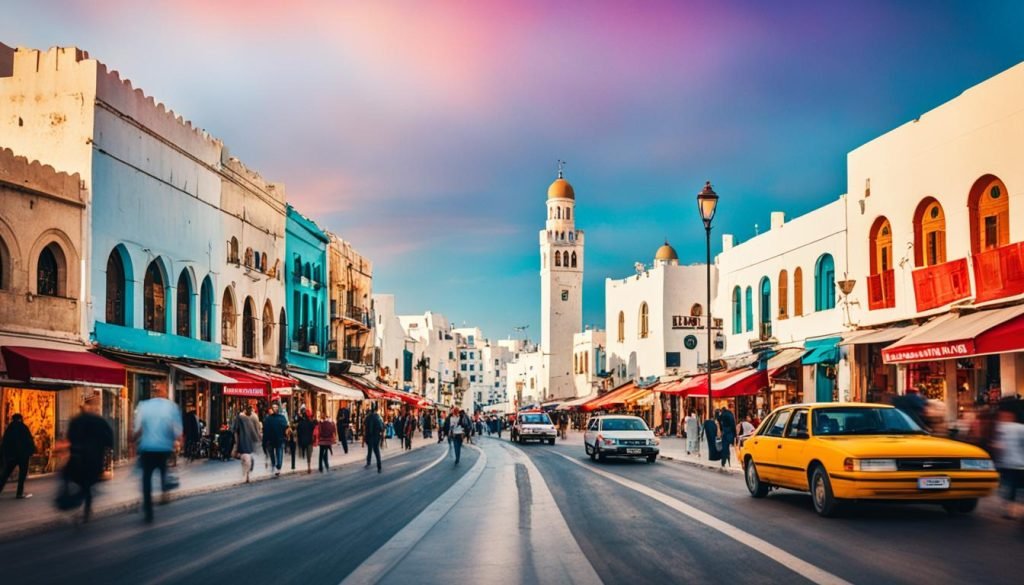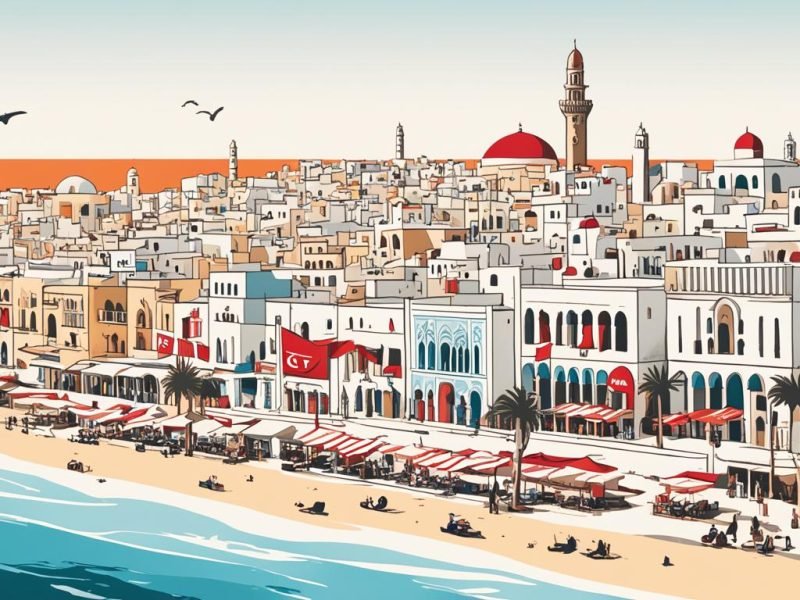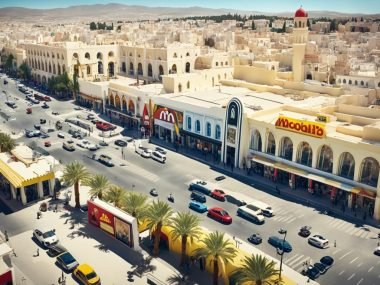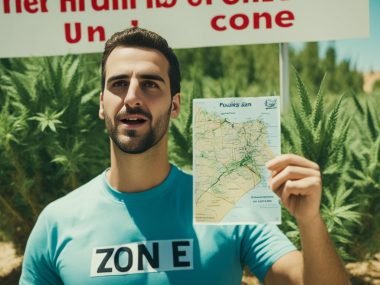Did you know nearly 85% of tourists mix up Tunis with Tunisia? Knowing the difference between Tunis, the lively capital city, and Tunisia, the diverse country, makes your visit much better. Tunis, on the northern coast, is the heart of Tunisia. Yet, it shows just a small part of the country’s rich history and wide geography. This stretches from the Atlas Mountains to the Sahara Desert.
We will compare Tunis and Tunisia in detail here. We’ll show what makes each place special. We’ll also look at how they connect in deep, important ways.
Key Takeaways
- The terms “Tunis” and “Tunisia” are often wrongly used for each other.
- Tunis is the capital city on Tunisia’s Northern coast.
- Tunisia is the whole country, full of history and geography from the Atlas Mountains to the Sahara Desert.
- Tunis reflects the country’s heritage and modern life in a small way.
- Knowing the difference between Tunis and Tunisia makes your trip better.
Introduction to Tunis and Tunisia
We will look at the Tunis and Tunisia Guide. We’ll explore what makes the city and country unique. You’ll learn about both their separate and connected traits.
Tunis Overview
As Tunisia’s heart, *Tunis* is its largest city and capital. It lies on the lovely Mediterranean coast. This city has a deep history and is important today. *Tunis* thrives in politics, business, culture, and more. It has a rich past, blending ancient charm with the new.
Tunisia Overview
Tunisia is in North Africa’s Maghreb region. It is next to Algeria and Libya. The country is a mix of many cultures like Phoenician and French. The capital is Tunis. It has varied landscapes and buildings that show the nation’s history and growth. Since 1956, Tunisia has been growing as its own modern state.
Etymology of Tunis
The name “Tunis” has deep historical roots. It blends influences from many cultures. Learning about its origins shows us the city’s rich cultural mix.
Arabic Origins
Arab geographer Yaqut al-Hamawi wrote about “Tunis.” He used forms like “Tūnus,” “Tūnas,” and “Tūnis.” These show how Arabic shaped Tunis’s identity. Its sounds link it to Arab-Islamic civilization.
Carthaginian Influence
The name Tunis might come from Tanith, a Carthaginian goddess. The Carthaginians influenced North Africa deeply. Some think the name is from the Berber word ens, meaning “to rest.” This idea connects to Berber traditions. Both theories show Tunis’s rich history.
Looking into Tunis’s name helps us see its unique culture. It highlights how Tunis and Tunisia have different stories. This journey into its past lets us value its cultural wealth more.
Etymology of Tunisia
The name Tunisia comes from its capital, Tunis. It shows the country’s rich past. “Tunisia” has links to many languages, especially the capital’s name.
Historical Background
The word “Tunisia” mixes Berber, Punic, and Roman words. Berbers called it something like “encampment.” This shows how old tribes lived.
Also, Tunisia was linked to ancient Carthage. This city had Phoenician and Roman influences. Such histories gave Tunisia its name.
Modern Usage
Later, “Tunisie” became popular in French. This was during French rule. This name spread worldwide.
Now, “Tunisia” carries both past and current stories. It’s more than a place name. It connects to the country’s deep history and culture.
Geographical Location of Tunis
Tunis is Tunisia’s capital. It’s in a special spot that makes it very important. It’s a key place for both local and world activities.
Coordinates and Map Placement
The exact spot of Tunis is 36°48′23″N 10°10′54″E. It’s on a beautiful coast, near hills. It’s close to the Lake of Tunis and the sea. This makes it an important coastal entry point. It’s good for the economy and culture.
Surrounding Areas
Tunis has some amazing places around it. Places like Sidi Bou Said with its blue and white buildings. It has great views of the sea. Then there’s Carthage, full of old ruins. And La Marsa, which has lovely beaches.

Tunis’s location makes it very special in Tunisia. It has busy spots and quiet places. This means it has a lively spirit and a rich history.
Geographical Location of Tunisia
Tunisia is in North Africa at 34°N 9°E, covering 163,610 km². It borders Algeria and Libya, and faces Italy across the sea.
Country Size and Borders
Though smaller than most African countries, Tunisia’s spot is strategically vital. It’s Africa’s northern tip and has Cape Angela. Tunis or Tunisia’s features, from north’s mountains to south’s desert, are diverse.
Major Cities and Regions
Tunis is the capital and a hub of culture and government. Cities like Sfax and Sousse show Tunisia’s vibrant economy and social life. There’s lots to see, from green coasts and valleys to dry lands near the Sahara.
Tunis: A Snapshot
Tunis blends the old and new beautifully. It’s a place where past and progress live together. The city welcomes everyone, showing its rich history and growing economy.
Population and Demographics
In 2023, about 599,368 people call Tunis home. It’s a main spot for many. The city mixes different cultures, showing its rich and varied background. Tunis changes with time, making its social scene lively and diverse.
Cultural and Economic Importance
Looking for info on Tunis or Tunisia? Both are key chapters. Tunis is not just about history; it’s also where the economy buzzes. It mixes old markets with new businesses. This way, it links the past to now.
Politics and business make Tunis central. It helps shape both nation and region.
The Tunisian Champs-Élysées is stunning. It’s like Paris but with Tunis’s spirit. This street shows how Tunis grows, blending now with age-old beauty. Tunis has lively markets and quiet parks. Each place tells Tunisia’s story, its past and hopes for tomorrow.
Tunisia: A Snapshot
Tunisia is a place where many cultures and people come together. It is home to about 11.7 million folks. It is known for having a good quality of life in Africa. Since gaining freedom, especially after the Tunisian Arab Spring, Tunisia has grown. It’s proud of its role in the world.
Historical Timeline of Tunis
Tunis has a long history that goes back thousands of years. It has seen many big events and changes. To really get the history of Tunis, we must look at its timeline. This shows how important Tunis has been in North Africa.

Ancient Settlements
Tunis started around the 4th century BC. It was an important place for the Carthaginians. People have found old things that show what life was like back then. This tells us a lot about Tunis and Tunisia Facts. Under the Romans, Tunis grew in trade and strategy.
Islamic Conquest
In the 7th century, Islam came to Tunis. This changed the city a lot in good ways. They built big places like the Zaytuna Mosque. This time made Tunis and its history very Islamic. It has left a big mark.
Colonial Era
Tunis changed a lot during the colonial times. It was ruled by Europeans and then the Ottomans. This period affected Tunis’s culture and society deeply. In 1956, Tunis became the capital of independent Tunisia. This showed its strength and ability to last through time.
Historical Timeline of Tunisia
Tunisia’s story goes from old times to now, filled with big events and cultural changes. It started with the rich history of Carthage. Then, it went through times under Roman rule. It saw a lot of growth during Islamic and Ottoman times.
From Carthage to Independence
Tunisia was first known for its strong Carthaginian era. It was a powerful place in the Mediterranean. After Carthage fell, the Romans took over. This made it very important for economy and administration. The 7th century brought Islam, changing its culture a lot.
The Ottomans later added to Tunisia’s history. The 19th century saw French rule. This changed how Tunisia’s people and politics worked. In 1956, Tunisia became independent. Leaders like Habib Bourguiba helped a lot. The journey to being on its own wasn’t easy but changed Tunisia greatly.
Modern Era and Politics
In recent times, Tunisia’s politics changed a lot because of the Tunisian Arab Spring in 2011. This revolution started a new chapter of democracy and changes in society. It was a very important time for modern Tunisia. The country’s focus on better governance and human rights shows its strong spirit.
Mixing its Tunisian history with today’s goals shows how Tunisia keeps growing worldwide.
Cultural Highlights of Tunis
Tunis is full of culture, making it a precious part of Tunisian heritage. It has beautiful historical places and lively festivals. These show how important Tunis is culturally.
Historic Sites
Visiting Tunis’s historical places is like going back in time. The ancient Medina, a UNESCO site, shows the city’s beautiful old buildings. The Roman Baths of Antoninus in Carthage let us see into the Roman times. They mix old glory with the beauty of nature.
The Zaytuna Mosque and its big minaret are also amazing. They are important for both their spiritual and architectural value. This mosque highlights how key Islamic culture is in the area.
Festivals and Events
Tunis isn’t just about history; it’s also full of modern culture. The Festival of Carthage happens every summer. It brings together artists and visitors from all over the world. This festival shows that Tunis’s culture is still lively and important today. It matters to everyone, both locals and tourists.
| Aspect | Details |
|---|---|
| Historic Sites | Ancient Medina, Roman Baths of Antoninus, Zaytuna Mosque |
| Festivals and Events | The Festival of Carthage |
Cultural Highlights of Tunisia
Exploring Tunisia’s culture reveals treasures of history and art. It has ancient Mosques and beautiful crafts. Tunisia’s heritage is very special and interesting.
Architectural Wonders
Tunisia’s buildings show the mix of cultures that have lived there. The Amphitheatre of El Jem is a Roman symbol. It shows their great building skills. The Great Mosque of Kairouan is important for worship. It’s a fine example of Islamic architecture.
“The architectural heritage of Tunisia stands as a testament to its rich and intertwined history.”
Traditional Arts and Crafts
Tunisian arts like rug making show old skills. The colourful markets sell jewellery, textiles, and ceramics. Each artwork tells a story, adding to Tunisia’s cultural wealth.
| Tunisian Architecture | Tunisian Arts |
|---|---|
| Amphitheatre of El Jem | Rug Making |
| Great Mosque of Kairouan | Pottery |
| Medina of Tunis | Jewellery Making |
Is It Tunis Or Tunisia?
Tunis and Tunisia are often mixed up. You need to look closely to understand how they are different. They each have their own story and identity.
Tunis is Tunisia’s capital, nestled on the Northern coast. It’s the biggest city in Tunisia, buzzing with life and activity. It is famous for politics, culture, and trade because of its great location.
Tunisia, the country, stretches from lovely beaches to the vast Sahara. It’s a place where many cultures have mixed over time. Since 1956, it has been known as the Republic of Tunisia.
“Is it Tunis or Tunisia? Both, but they each tell a different part of the fascinating story of this North African region.”— local historian.
Let’s make it simple to understand the differences:
| Aspect | Tunis | Tunisia |
|---|---|---|
| Geographical Location | Northern coast, near the Gulf of Tunis | North Africa, spanning from the Mediterranean Sea to the Sahara desert |
| Political Importance | Capital city and political hub | Independent republic since 1956 |
| Historical Influence | Centre for trade, cultural exchanges, and governance | Influenced by Phoenician, Roman, Arab, and French cultures |
| Modern Identity | Largest city with bustling cultural life | Diverse nation with a rich cultural heritage |
Understanding Tunis and Tunisia’s unique roles helps us see their value. Tunis is a vital part of Tunisia and its story.
Conclusion
My journey into Tunis and Tunisia revealed their deep and rich identities. Tunis, the busy city, mixes old beauty with new life. It shines as the heart of both politics and culture. Tunisia, the country, shows off its varied landscapes and long history. It tells a story of strength in the Maghreb and beyond.
To grasp their differences matters a lot. Tunis is where history and today meet, showing the rich culture of Tunisia. Across the wider border, Tunisia’s buildings and art highlight its world role. This gives us precious views into Tunisian tradition.
Looking at Tunisia’s growth, changes in Tunis and the nation stand out. They carry a proud history into a hopeful future. The bond between Tunis and Tunisia shows a story loved by locals and the world. This trip lets us see how the city and country are closely linked.







